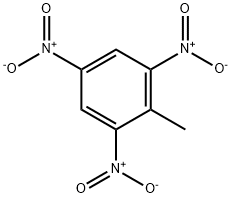CHEMICAL AND PHYSICAL PROPERTIES
| Physical Description | Tnt, wetted with not less than 30% water appears as a slurry of a yellow water-insoluble crystalline solid. Can burn, although difficult to ignite. When water has been driven off or evaporated the residue is easily ignited, burns vigorously, and is highly explosive. Produces toxic oxides of nitrogen during combustion. May explode under exposure to intense heat. Primary hazard is blast of an explosion, not flying projectiles or fragments. |
|---|---|
| Color/Form | Monoclinic rhombohedra from alc; commercial crystals (needles) are yellow |
| Odor | Odorless |
| Boiling Point | 464 °F at 760 mmHg EXPLODES (NTP, 1992) |
| Melting Point | 177.6 °F (NTP, 1992) |
| Flash Point | (Explodes) (NIOSH, 2023) |
| Solubility | Insoluble (NTP, 1992) |
| Density | 1.654 at 68 °F (NTP, 1992) - Denser than water; will sink |
| Vapor Density | 7.85 (Air = 1) |
| Vapor Pressure | 0.046 mmHg (NTP, 1992) |
| LogP | 1.6 |
| Decomposition | Heat of decomposition was determined as 5.1 kJ/g. |
| Ionization Potential | 10.59 eV |
| Kovats Retention Index | 1704 1693 |
| Other Experimental Properties | Dipole moment 1.37 |
| Chemical Classes | Other Uses -> Explosives |
SAFETY INFORMATION
| Signal word | Danger |
|---|---|
| Pictogram(s) |
 Flame Flammables GHS02  Exclamation Mark Irritant GHS07 |
| GHS Hazard Statements |
H225:Flammable liquids H319:Serious eye damage/eye irritation |
| Precautionary Statement Codes |
P210:Keep away from heat/sparks/open flames/hot surfaces. — No smoking. P261:Avoid breathing dust/fume/gas/mist/vapours/spray. P337+P313:IF eye irritation persists: Get medical advice/attention. P403+P235:Store in a well-ventilated place. Keep cool. |
COMPUTED DESCRIPTORS
| Molecular Weight | 227.13 g/mol |
|---|---|
| XLogP3 | 1.6 |
| Hydrogen Bond Donor Count | 0 |
| Hydrogen Bond Acceptor Count | 6 |
| Rotatable Bond Count | 0 |
| Exact Mass | 227.01783489 g/mol |
| Monoisotopic Mass | 227.01783489 g/mol |
| Topological Polar Surface Area | 138 Ų |
| Heavy Atom Count | 16 |
| Formal Charge | 0 |
| Complexity | 292 |
| Isotope Atom Count | 0 |
| Defined Atom Stereocenter Count | 0 |
| Undefined Atom Stereocenter Count | 0 |
| Defined Bond Stereocenter Count | 0 |
| Undefined Bond Stereocenter Count | 0 |
| Covalently-Bonded Unit Count | 1 |
| Compound Is Canonicalized | Yes |
PRODUCT INTRODUCTION
description
2,4,6-Trinitrotoluene is a yellow, odorless solid that does not occur naturally in the environment. It is commonly known as TNT and is an explosive used in military shells, bombs, and grenades, in industrial uses, and in underwater blasting. 2,4,6-Trinitrotoluene production in the United States occurs solely at military arsenals.

